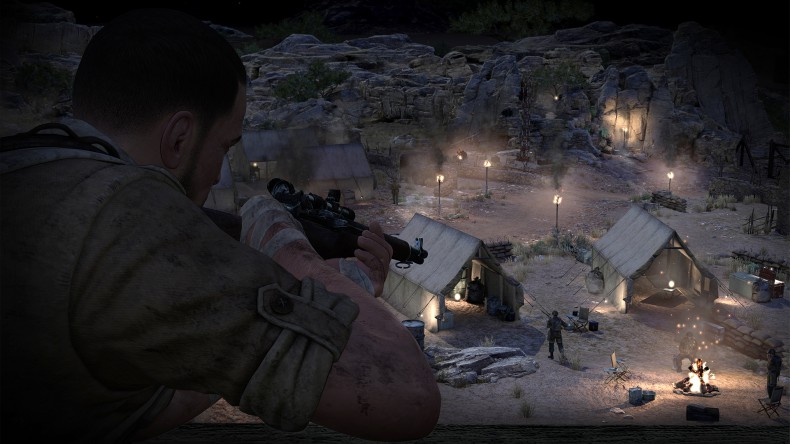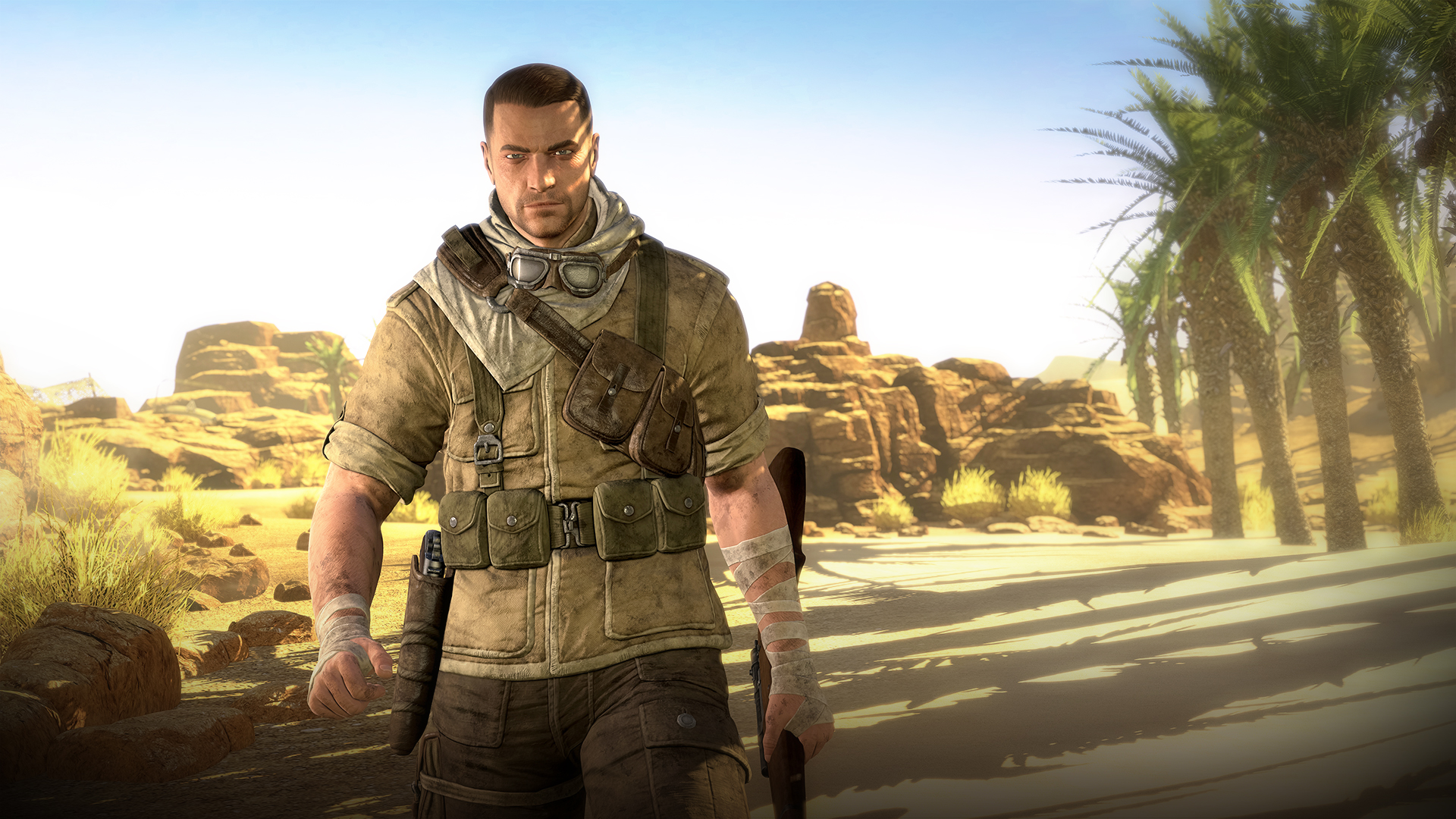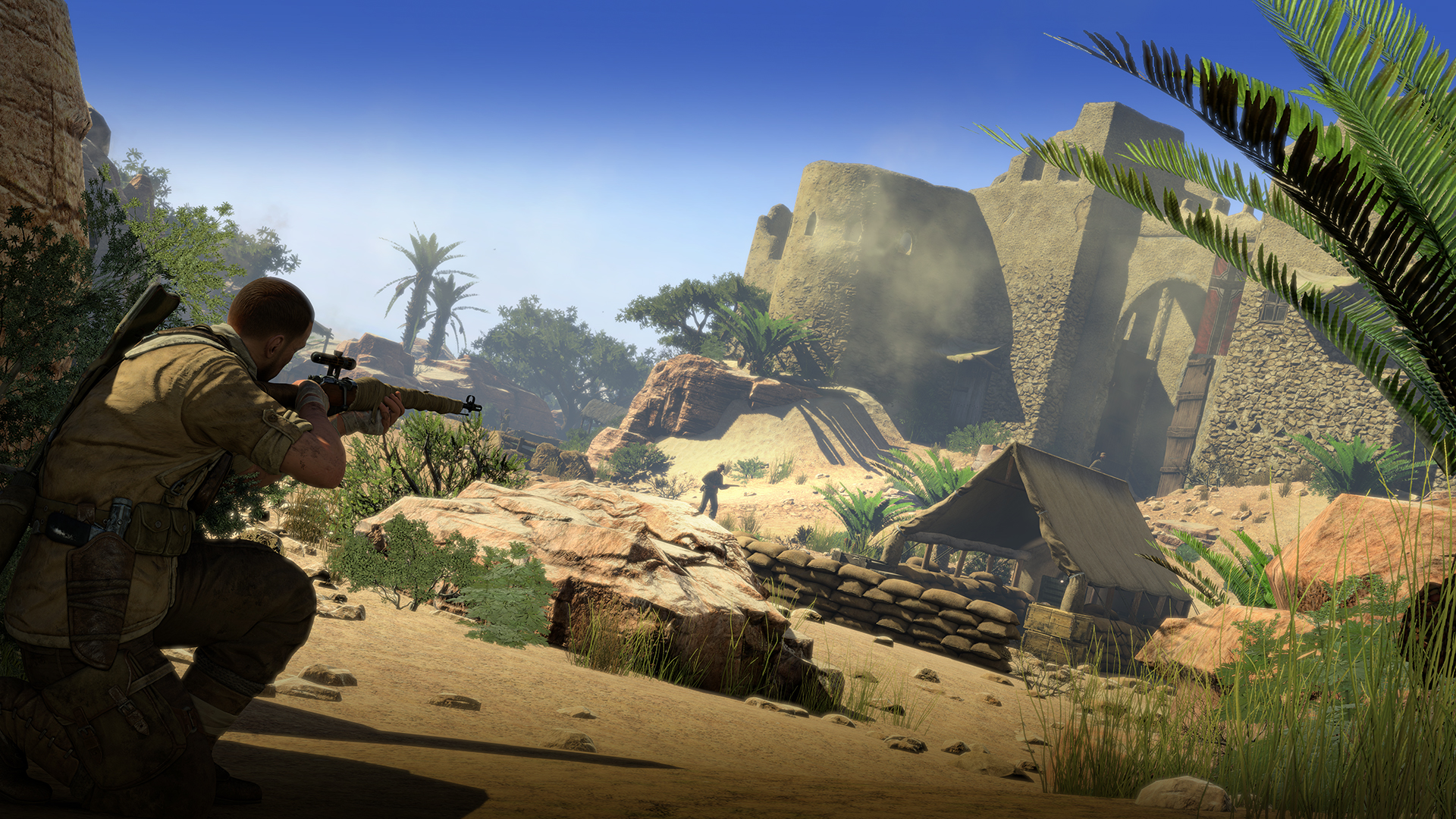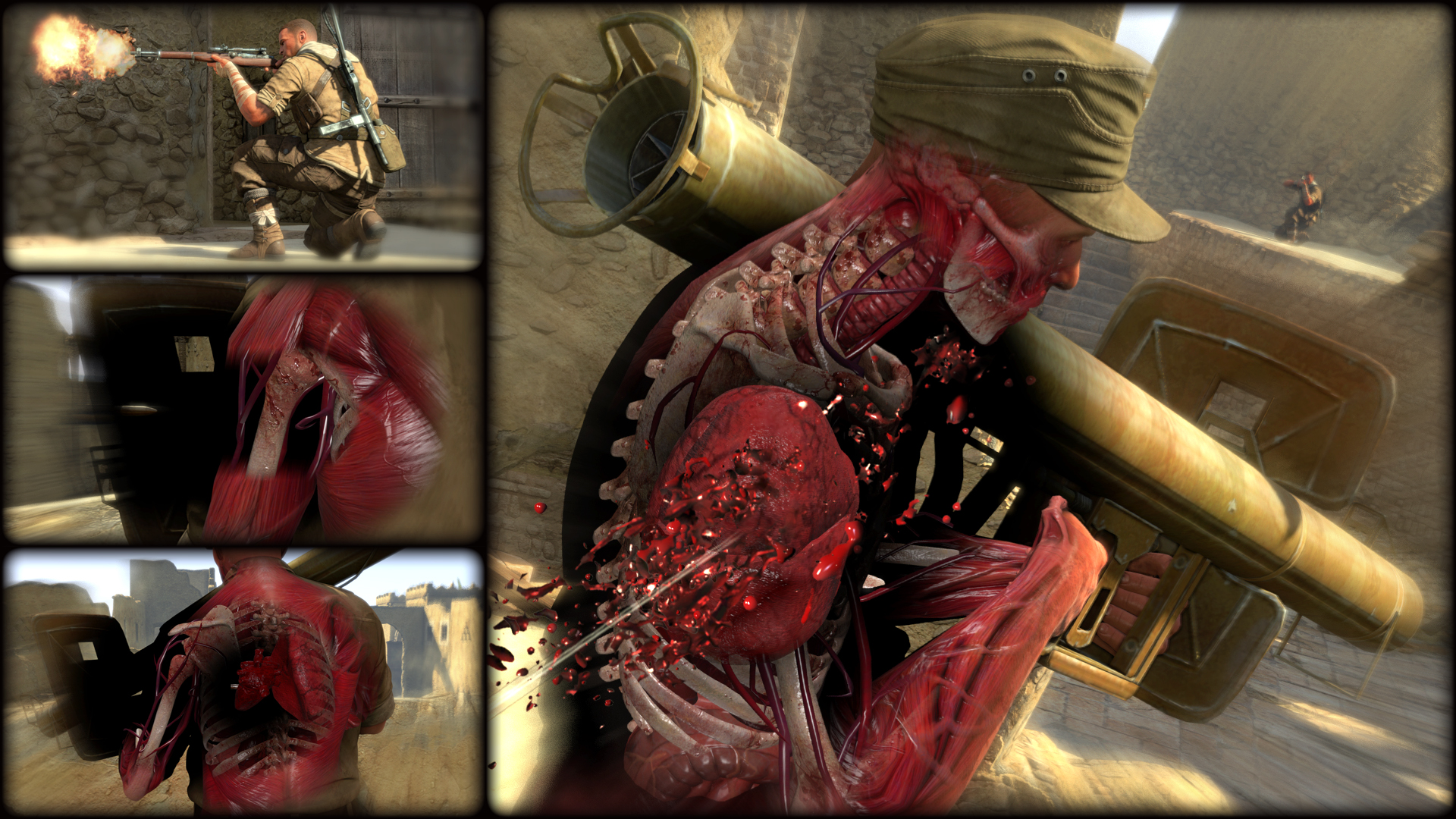Sniper Elite III Review

+ Sniping is incredibly satisfying
+ Good stealth mechanics
+ X-Ray Cam
+ Huge, expansive maps
+ Tiered objectives
+ Overwatch co-op
- The writing
- Color palette is dull
- Sand, sand, stone and more sand
- Karl isn't a very interesting character
- Some technical issues such as screen tearing and an instance or two of dropped framerate
- Multiplayer is meh
- No one playing online a week after launch
Sniper Elite III offers fans of stealth a bunch of fun playgrounds to let loose in, with visceral kills and great sound. What it doesn't offer is a story of any consequence, it serves as merely an excuse to be at each playground, has no heart, says nothing about war or its lead character. With that said, ignore the story and just have fun killing Nazis.
I want to get one thing out of the way, straight away. If you are a gamer that prefers story to gameplay, stop reading now because Sniper Elite III is all about the gameplay. The “story,” such as it is, feels 100% like it was the last thing Rebellion thought about and added to the game. Continuing the adventures of OSS officer, Karl Fairburne, Sniper Elite III brings him and the player to the conflict in North Africa in later WWII on the trail of Vahlen and his Afrika Korps who, as Karl has discovered, are developing a “wunderwaffe” – wonder weapon. This very thin story thread takes Karl across 8 different locations in Northern Africa, and places him behind enemy lines with his stealth and marksman skills. Each mission has some kind of objective, which leads him to the next mission until he finally reaches the HQ where this “wunderwaffe” is being assembled.
On it’s own, the story doesn’t sound too bad, but coupled with the fact that there are almost no characters in the game besides Karl, there is really nothing or no one to cling to other than Karl, and Karl is just bad. Generic in every conceivable way; humorless, deep voiced, hard bitten tough guy, and nearly everything he says is cringe-worthy due to it’s utter lack of flavor or joy. Two other characters show up later in the game and none leave any impression whatsoever because they literally take up about five and three minutes screen time, respectively, in a 10-12 hour game. The “story” doesn’t have anything to say about Karl, war, or anything really and it’s really nothing more than a flimsy excuse to put the player in each level and a reason to leave when the mission is done.

This is Karl, completely nondescript and outside of his stunning ability to kill people in fun ways, isn’t very interesting.
Once I accepted the fact that I was never going to care about the story, I totally immersed myself into the gameplay and I’m glad I did, because once I got into the mechanics of the game, I had so much more fun. Rebellion uses a lot of things that work together to make the game fun. First of all, it controls well. Movement and aiming is similar to most shooters with left trigger aiming and right trigger shooting, tap B (or Circle on PS4) to crouch, hold to go prone, A (X) to climb, X (Square) to reload, etc. so having any experience with shooters makes the game easy to pick up. Where it gets more intricate is with its sniping, which is the main gameplay mechanic of the Sniper Elite series, opting for a more “realistic” approach than other games. Simply aiming my cross hairs on a target and pulling the trigger will not suffice because depending on the distance to said target, bullet curve will become a factor that you have to account for and it takes a bit of time to line up. Not too much time, but just enough to make it all the more satisfying when a bullet hits the intended mark. To make this process easier, tapping the right bumper goes into “focus” mode, which basically allows you to hold your breath to steady your shot. A small red “X” will narrow as your shot gets lined up, at it’s smallest, pull the trigger and watch the bullet fly.
Once the bullet has left the barrel, the camera takes over and follows the bullet in slow motion as it flies through the air, getting slower as it reaches the target, then going into Sniper Elite’s patented “X-ray Cam” which shows the organs and skeleton of the victim as the bullet passes through and destroys whatever it comes into contact with; lungs, heart, liver, face, eyeballs, bones and even testicles. Yes, the game even shows testicles being obliterated by your bullets. Whatever it hits, it’s always gruesome and always satisfying, both visually and auditorily. The squish and cracking of bones is presented with gleefully sickening detail to accompany the impact. I should note that this can be skipped or turned off all together if for some reason you get tired of seeming eyeballs, livers, hearts, bones and such explode into a bloody mess.
As satisfying as this mechanic is, it would get boring pretty quick if all Sniper Elite III had to offer was a series of linear shooting galleries. Instead, each of the 8 maps is fairly expansive, with quite a lot of variety in how you can approach each situation. Each level has 3 “Sniper’s Nests” that can be accessed for a clear view of the surrounding area, and patient players can tag enemies with their binoculars, follow their movements, and pick each one off at their discretion.
For players like myself, that love stealth, remaining unseen, and taking every single enemy out, there are things in the environment that can be used to “mask the sound” of every shot you take. Remember, this is WWII so there aren’t silenced sniper rifles. Every shot is loud and will give away your position if you don’t wait for the most opportune moment to take each shot. To this end, there are generators you can sabotage that will cause a loud noise when it kicks back, which is when you should take your shot. The game tells you when a shot will be unheard by a visual representation of a sound on the top middle of the screen. However, you’ll need to take your shot reasonably quickly because the window is always brief. I found myself counting down between moments of kick back so I could be ready as soon as it started. I was also able to use planes flying overhead, artillery canon fire, and general sounds of the environment to mask my shots as well.
If I did take a shot outside of sound masking, a yellow alert would show up on the lower left corner of the HUD, indicating that the sound was heard and the enemies are more alert. Taking one more shot changed the yellow to red and now the enemy has a general idea of where they should be looking for me. Similar to Splinter Cell’s “Last Known Position,” a white outline of where I last was would appear on the screen signifying where the enemy would be looking and aiming their aggression, allowing me to stealthily relocate myself, and take out more enemies. I also set up traps to lure enemies into with trip and landmines, making the path to get to me deadly for enemies brave enough to attempt it. Oh and protip: setting trip and land mines in the paths of vehicles is much easier than shooting them.
Not all portions of missions allow for good sniping opportunities, so an up close and personal approach is required from time to time. For these instances you are armed with a Welrod, a single shot, relatively primitive silenced pistol that allows for closer, silent kills when aimed at an enemies head. This allows you to more easily take out the sentry’s that permeate the maps in close quarters situations. There are also stealth takedowns in the game which consist of stabbing and snapping enemy necks a whole lot.
Objectives vary from mission to mission and there are always multiple tiers. Several missions begin with a primary objective, that once completed, leads to another and then another. This beefs up the length of the missions and depending on how I approached them, usually as stealthily and tactical as possible, missions could last north of an hour each. Adding in optional objectives, missions would last even longer. Optional objectives, however, kind of have to be stumbled upon either by entering an area that will trigger them, or viewing the objective through your binoculars. The pause menu does let you know how many optional objectives there are in each mission; it’s just up to you to find them.
The AI is pretty much all over the place. Most of the time they don’t notice their dead allies who are no longer stationed at their position but rather lying dead with a hole in their face or kidneys. Other times they can spot you with ridiculous accuracy and quickness. While the latter makes the game more intense, the former undermines the tension with an unfortunate regularity.
Visually, it’s pretty clear than Sniper Elite III was designed with last gen as the lead platforms because on Xbox One, the game looks like an uprezzed version of a last gen game. So if you haven’t yet made the jump to the current gen, don’t worry about missing out on anything in the visuals department. While textures looked decent, nothing popped and at a cursory glance, you would be hard pressed to tell it was being played on a current gen system. There is also some screen tearing and in a few dense areas the framerate would stutter when I panned the camera, only to right itself when I looked at a wall behind me. And while I do admire the variety of level in terms of design and layout, aesthetically, it doesn’t offer much variety in terms of color. If anyone was tired of brown shooters before, Sniper Elite III‘s abundance of sand, with a bit of shrubbery thrown in, really isn’t going to do them any favors.

Levels are pretty huge and offer a lot of different ways to approach each objective. Just make sure you like the color of sand and rocks, because you’re going to see a lot of them.
One area where I feel like Sniper Elite III does benefit from being on current gen platforms are load times and the save anywhere feature. Going into the save menu is incredibly fast, saving even faster. I clicked the button to save and my game was saved. There was no “please wait” or save confirmation. It’s impressively fast and something I have been hoping for with these new consoles. Also impressively fast are the load times. Even these huge levels only take a couple of seconds to load and restarting from my last save was the same. Press the accept button, about 2 seconds of black screen and I was back in the game. It really made self-restarting because I was spotted as painless as possible. Good stuff, right there.
In terms of sound, Rebellion really knocked it out of the park. Guns sound like guns do in real life. Sharp and loud, the only time there seems to be any enhancements are when the bullets leave the rifle during a kill cam, mostly because of the slow motion and a flanger mixed with phaser type effect to accentuate the velocity of the bullet as it travels through the air. Depending on the environment, shots would echo and bounce around my surround sound, using it to great effect. The Nazi conversations were all executed well and sounded authentic. The only weak spot is the voice acting for Karl. Like I mentioned earlier, it’s just so painfully generic that it’s almost comical. There is an extremely late game exchange between Vahlen and Karl that is unbelievably rote and leads to Karl being relatively indignant giving him a closing line of dialogue that makes absolutely no sense as it was never a theme of the game.
There is also a multiplayer suite available for the game, and the less said about it the better. While two game modes stood out, Distance King and No Cross, Team Deathmatch just wasn’t for me. As someone who is primarily into objective based gameplay in his multiplayer games, Team Deathmatch has always left me cold and putting it in a game focused on sniping makes me even colder. It also allows players to get close and take out opponents, completely making sniping pointless. Distance King and No Cross stand out because they allow for the game mechanics themselves to shine. In Distance King, kills get more points the further the player is from their target. In No Cross, there are lines that can’t be crossed by the opposing team so it’s all sniping, all the time.
The major issue with multiplayer is that, at least on Xbox One, it’s a barren wasteland. Trying specific modes turned up no results and in Quick Matches I managed to join a few matches with only 4 people in them.
There are also some co-op modes on offer, including full campaign co-op, Survival, and Overwatch. Survival is a basic horde-like mode and Overwatch allows for one player to spot for the other with asymmetrical co-op gameplay. It’s a fun distraction, but hardly something that is going to pull people in. And if my experience with finding people to play with less than week after release is any indication, this game is pretty much DOA when it comes to online, unfortunately.
At the end of the day, reviewing Sniper Elite III has been an interesting situation for me, to say the least. While I thoroughly enjoyed the gameplay, the huge missions, the expansive maps and the way the game is designed to be played how the player wants, it’s constantly mired by nagging issues such as limited variety in the color palette, some glaring lack of polish and, how can I put this delicately, terrible writing. With that said, I am more than happy with the time I spent with Sniper Elite III and as a reasonably “budget” title, I think fans of stealth, sniping, and graphic violence will have a lot to enjoy here.
SpawnFirst Recommends…
Sniper Elite III offers fans of stealth a bunch of fun playgrounds to let loose in, with visceral kills and great sound. What it doesn’t offer is a story of any consequence, it serves as merely an excuse to be at each playground, has no heart, says nothing about war or its lead character. With that said, ignore the story and just have fun killing Nazis.













